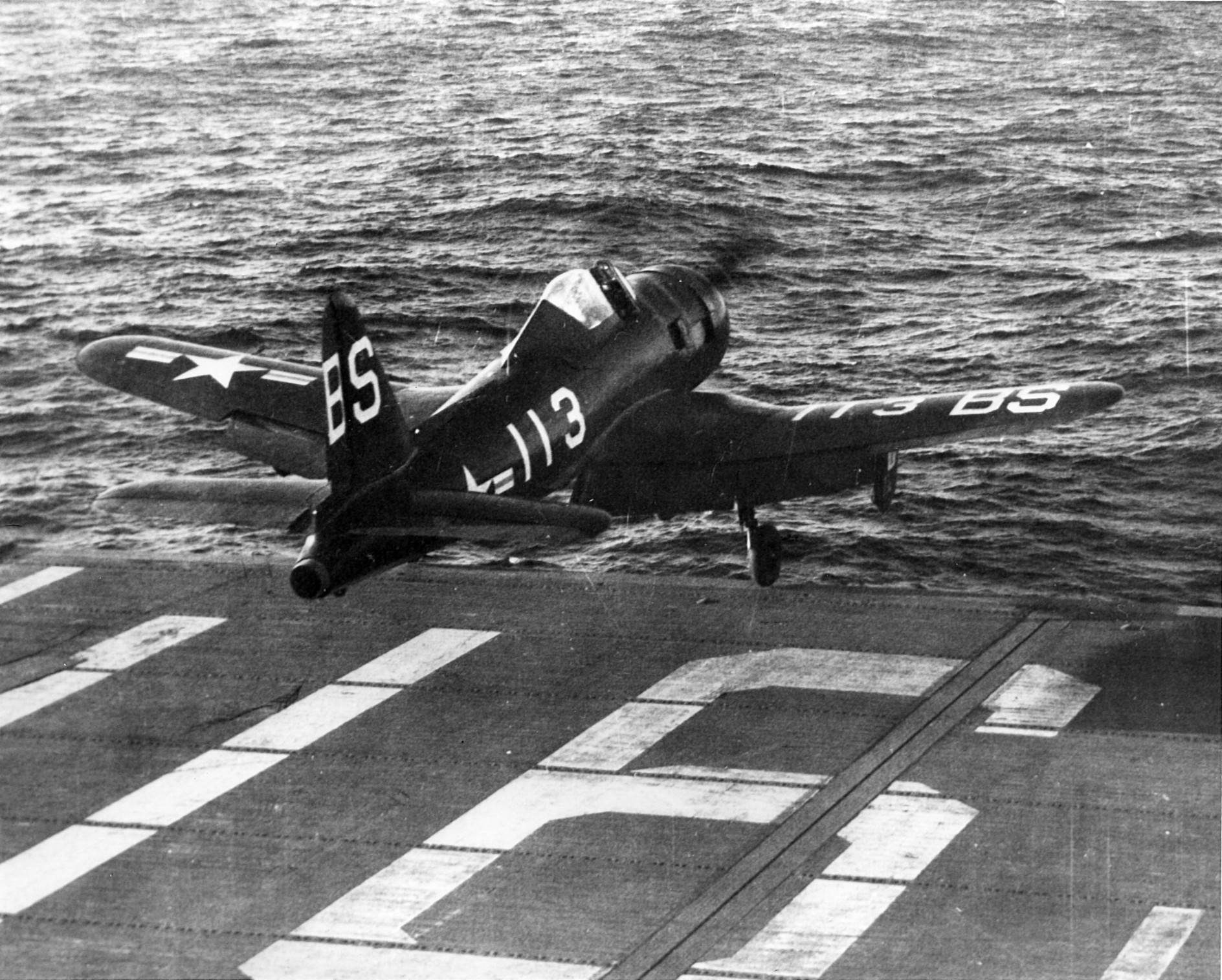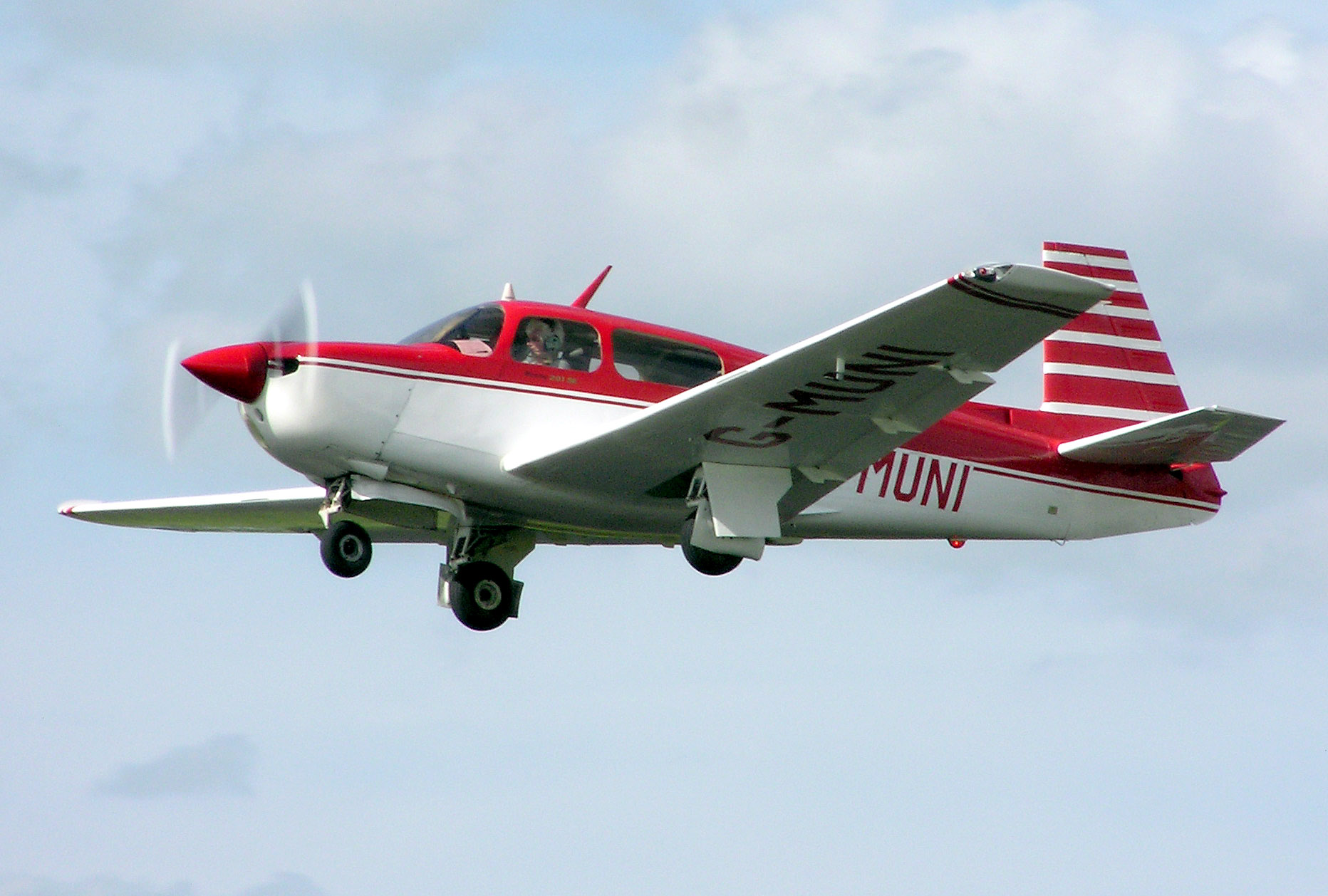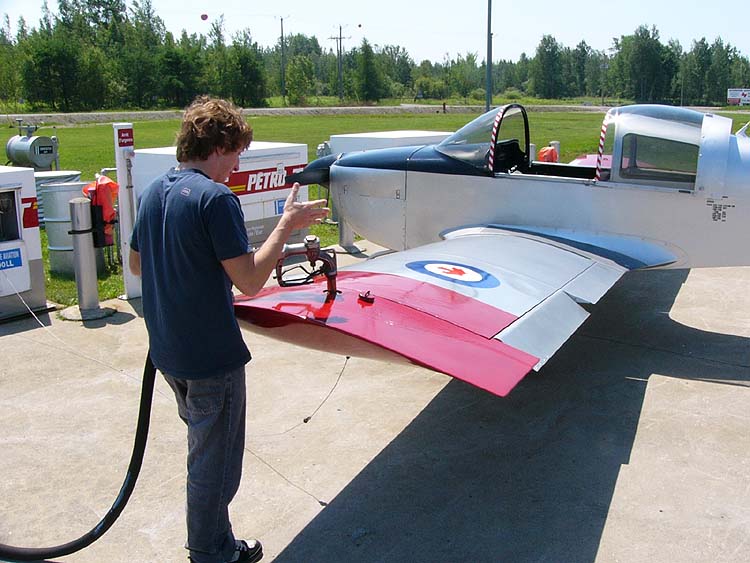|
Ryan FR-1 Fireball
The Ryan FR Fireball is an American mixed-power (piston and jet-powered) fighter aircraft designed by Ryan Aeronautical for the United States Navy during World War II. It was the Navy's first aircraft with a jet engine. Only 66 aircraft were built before Japan surrendered in August 1945. The FR-1 Fireball equipped a single squadron before the war's end, but did not see combat. The aircraft ultimately proved to lack the structural strength required for operations aboard aircraft carriers and was withdrawn in mid-1947. Design and development Design of the FR-1 began in 1943 to a proposal instigated by Admiral John S. McCain Sr. for a mixed-powered fighter because early jet engines had sluggish acceleration that was considered unsafe and unsuitable for carrier operations. Ryan received a contract for three XFR-1 prototypes and one static test airframe on 11 February 1943 with the first two prototypes delivered in 14 months. Another contract was placed for 100 aircraft on 2 Dec ... [...More Info...] [...Related Items...] OR: [Wikipedia] [Google] [Baidu] |
VF-66
Fighter Squadron 66 (VF-66), known as the Firebirds, was a fighter squadron of the United States Navy established during World War II. Operational history VF-66 was established on 1 January 1945 equipped with the Ryan FR Fireball, FR-1 Fireball. The squadron was slated for the Pacific War, Pacific, however never saw combat and was disestablished on 18 October 1945. See also * List of inactive United States Navy aircraft squadrons References Strike fighter squadrons of the United States Navy {{USN-stub ... [...More Info...] [...Related Items...] OR: [Wikipedia] [Google] [Baidu] |
Tricycle Landing Gear
Tricycle gear is a type of aircraft undercarriage, or ''landing gear'', that is arranged in a tricycle fashion. The tricycle arrangement has one or more nose wheels in a single front undercarriage and two or more main wheels slightly aft of the center of gravity. Tricycle gear aircraft are the easiest for takeoff, landing and taxiing, and consequently the configuration is now the most widely used on aircraft.Crane, Dale: ''Dictionary of Aeronautical Terms, third edition'', page 524. Aviation Supplies & Academics, 1997. Aviation Publishers Co. Limited, ''From the Ground Up'', page 11 (27th revised edition) History Several early aircraft had primitive tricycle gear, notably very early Antoinette planes and the Curtiss Pushers of the pre-World War I Pioneer Era of aviation. Waldo Waterman's 1929 tailless '' Whatsit'' was one of the first to have a steerable nose wheel. In 1956, Cessna introduced sprung-steel tricycle landing gear on the Cessna 172. Their marketing depart ... [...More Info...] [...Related Items...] OR: [Wikipedia] [Google] [Baidu] |
50 BMG
The .50 BMG (.50 Browning Machine Gun), also known as 12.7×99mm NATO, and designated as the 50 Browning by the C.I.P., is a 12mm caliber, caliber cartridge developed for the M2 Browning heavy machine gun in the late 1910s, entering official service in 1921. Under STANAG#Partial list, STANAG 4383, it is a standard service Cartridge (firearms), cartridge for NATO forces. The cartridge itself has been made in many variants: multiple generations of regular full metal jacket bullet, ball, tracer ammunition, tracer, armor-piercing bullet, armor-piercing (AP), Incendiary ammunition, incendiary, and Sabot (firearms), saboted Sub-caliber ammunition, sub-caliber Saboted light armor penetrator, penetrator rounds. The rounds intended for machine guns are made into a continuous belt (firearms), ammunition belt using metallic links. The .50 BMG cartridge is also used in anti-materiel rifles. A wide variety of ammunition is available, and the availability of match grade ammunition has increa ... [...More Info...] [...Related Items...] OR: [Wikipedia] [Google] [Baidu] |
Airfoil
An airfoil (American English) or aerofoil (British English) is a streamlined body that is capable of generating significantly more Lift (force), lift than Drag (physics), drag. Wings, sails and propeller blades are examples of airfoils. Foil (fluid mechanics), Foils of similar function designed with water as the working fluid are called hydrofoils. When oriented at a suitable angle, a solid body moving through a fluid deflects the oncoming fluid (for fixed-wing aircraft, a downward force), resulting in a force on the airfoil in the direction opposite to the deflection. This force is known as aerodynamic force and can be resolved into two components: lift (perpendicular to the remote freestream velocity) and drag (Parallel (geometry), parallel to the freestream velocity). The lift on an airfoil is primarily the result of its angle of attack. Most foil shapes require a positive angle of attack to generate lift, but Camber (aerodynamics), cambered airfoils can generate lift at zero ... [...More Info...] [...Related Items...] OR: [Wikipedia] [Google] [Baidu] |
Laminar Flow
Laminar flow () is the property of fluid particles in fluid dynamics to follow smooth paths in layers, with each layer moving smoothly past the adjacent layers with little or no mixing. At low velocities, the fluid tends to flow without lateral mixing, and adjacent layers slide past one another smoothly. There are no cross-currents perpendicular to the direction of flow, nor eddies or swirls of fluids. In laminar flow, the motion of the particles of the fluid is very orderly with particles close to a solid surface moving in straight lines parallel to that surface. Laminar flow is a flow regime characterized by high momentum diffusion and low momentum convection. When a fluid is flowing through a closed channel such as a pipe or between two flat plates, either of two types of flow may occur depending on the velocity and viscosity of the fluid: laminar flow or turbulent flow. Laminar flow occurs at lower velocities, below a threshold at which the flow becomes turbulent. The thresh ... [...More Info...] [...Related Items...] OR: [Wikipedia] [Google] [Baidu] |
Bubble Canopy
A bubble canopy is an aircraft canopy constructed without bracing, for the purpose of providing a wider unobstructed field of view to the pilot, often providing 360° all-round visibility. The designs of bubble canopies can vary drastically; some, such as on later versions of the F4U Corsair, are built into the upper rear fuselage, while others, like the canopy of the P-51D Mustang and most modern combat aircraft, are built flush with the fuselage, providing unobstructed rear visibility. Although experimented with as early as the First World War, the bubble canopy was brought into widespread use during the Second World War, being used by a number of American, British, and Japanese aircraft, commonly fighters. During the postwar era, the bubble canopy became a common feature of jet-powered fighter aircraft. Outside of combat aircraft, such canopies have also been adopted by several helicopters and general aviation aircraft, often for roles that benefit from a high level of exte ... [...More Info...] [...Related Items...] OR: [Wikipedia] [Google] [Baidu] |
Cockpit
A cockpit or flight deck is the area, on the front part of an aircraft, spacecraft, or submersible, from which a pilot controls the vehicle. The cockpit of an aircraft contains flight instruments on an instrument panel, and the controls that enable the pilot to fly the aircraft. In most airliners, a door separates the cockpit from the aircraft cabin. After the September 11, 2001 attacks, all major airlines fortified their cockpits against access by hijackers. Etymology The word cockpit seems to have been used as a nautical term in the 17th century, without reference to cock fighting. It referred to an area in the rear of a ship where the cockswain's station was located, the cockswain being the pilot of a smaller "boat" that could be dispatched from the ship to board another ship or to bring people ashore. The word "cockswain" in turn derives from the old English terms for "boat-servant" (''coque'' is the French word for "shell"; and ''swain'' was old English for boy ... [...More Info...] [...Related Items...] OR: [Wikipedia] [Google] [Baidu] |
Self-sealing Fuel Tank
A self-sealing fuel tank (SSFT) is a type of fuel tank, typically used in aircraft fuel tanks or fuel bladders, that prevents them from leaking fuel and igniting after being damaged. Typical self-sealing tanks have layers of rubber and reinforcing fabric, one of vulcanized rubber and one of untreated natural rubber, which can absorb fuel when it comes into contact with it. When a fuel tank is punctured the fuel seeps into these layers, causing the untreated layer to swell, closing and thus sealing the puncture. A similar concept is also employed for making self-sealing run-flat tires. History World War I George J. Murdock applied for the patent "War Aeroplane Fuel Tanks" on February 7, 1917 but was temporarily blocked by an order of the Federal Trade Commission, on February 6, 1918, to keep any discussion or publication of the invention secret. The order was rescinded by the United States Patent Office on September 26, 1918 and Murdock was eventually granted "Self-Punctur ... [...More Info...] [...Related Items...] OR: [Wikipedia] [Google] [Baidu] |
Avgas
Avgas (aviation gasoline, also known as aviation spirit in the United Kingdom, UK) is an aviation fuel used in aircraft with spark-ignited internal combustion engines. ''Avgas'' is distinguished from conventional gasoline (petrol) used in motor vehicles, which is termed ''mogas'' (motor gasoline) in an aviation context. Unlike motor gasoline, which has been formulated without lead since the 1970s to allow the use of catalytic converters for pollution reduction, the most commonly used grades of avgas still contain tetraethyllead, tetraethyl lead, a toxic lead-containing additive used to aid in lubrication of the engine, increase octane rating, and prevent engine knocking (spark-knock). There are ongoing efforts to reduce or eliminate the use of lead in aviation gasoline. Kerosene-based jet fuel is formulated to suit the requirements of gas turbine, turbine engines which have no octane requirement and operate over a much wider flight envelope than piston engines. Kerosene is also ... [...More Info...] [...Related Items...] OR: [Wikipedia] [Google] [Baidu] |
Wing Root
The wing root is the part of the wing on a fixed-wing aircraft or winged-spaceship that is closest to the fuselage,Peppler, I.L.: ''From The Ground Up'', page 9. Aviation Publishers Co. Limited, Ottawa Ontario, Twenty Seventh Revised Edition, 1996. and is the junction of the wing with the fuselage (not with a nacelle or any other body). The term is also used for the junction of the wing with the opposite wing, ie on the fuselage centerline, as with the upper wing of a biplane. The opposite end of a wing from the wing root is the wing tip. The aerodynamic properties of the overall aircraft can be greatly impacted by the shaping and other design choices of the wing root. During both normal flight and landings, the wing root of an aircraft would be typically subjected to the highest bending forces through the aircraft. As a means of reducing interference drag between the wing and the fuselage, the use of fairings (often referred to as "wing fillets") became commonplace during t ... [...More Info...] [...Related Items...] OR: [Wikipedia] [Google] [Baidu] |
Fuselage
The fuselage (; from the French language, French ''fuselé'' "spindle-shaped") is an aircraft's main body section. It holds Aircrew, crew, passengers, or cargo. In single-engine aircraft, it will usually contain an Aircraft engine, engine as well, although in some amphibious aircraft the single engine is mounted on a hardpoint, pylon attached to the fuselage, which in turn is used as a floating Hull (watercraft), hull. The fuselage also serves to position the Flight control surfaces, control and Stabilizer (aeronautics), stabilization surfaces in specific relationships to Wing, lifting surfaces, which is required for aircraft stability and maneuverability. Types of structures Truss structure This type of structure is still in use in many lightweight aircraft using welding, welded steel tube trusses. A box truss fuselage structure can also be built out of wood—often covered with plywood. Simple box structures may be rounded by the addition of supported lightweight strin ... [...More Info...] [...Related Items...] OR: [Wikipedia] [Google] [Baidu] |
Turbojet
The turbojet is an airbreathing jet engine which is typically used in aircraft. It consists of a gas turbine with a propelling nozzle. The gas turbine has an air inlet which includes inlet guide vanes, a compressor, a combustion chamber, and a turbine (that drives the compressor). The compressed air from the compressor is heated by burning fuel in the combustion chamber and then allowed to expand through the turbine. The turbine exhaust is then expanded in the propelling nozzle where it is accelerated to high speed to provide thrust. Two engineers, Frank Whittle in the United Kingdom and Hans von Ohain in Germany, developed the concept independently into practical engines during the late 1930s. Turbojets have poor efficiency at low vehicle speeds, which limits their usefulness in vehicles other than aircraft. Turbojet engines have been used in isolated cases to power vehicles other than aircraft, typically for attempts on land speed records. Where vehicles are "turbine-powere ... [...More Info...] [...Related Items...] OR: [Wikipedia] [Google] [Baidu] |







